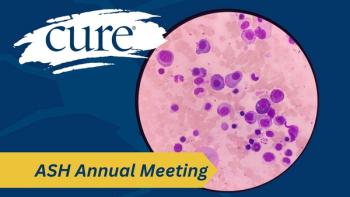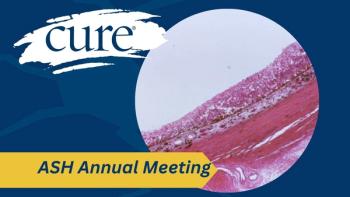
Jemperli Plus Chemo Continues to Demonstrate Strong Outcomes in Advanced NSCLC
Jemperli plus chemotherapy demonstrated improvement in overall survival compared with Keytruda and chemotherapy in patients with treatment-naïve, nonsquamous non–small cell lung cancer.
Patients with treatment-naïve, nonsquamous non-small cell lung cancer (NSCLC) experienced a higher objective response rate (ORR, patients whose disease responded to treatment) and improvements in overall survival (OS, the time a patient lives following treatment) when treated with Jemperli (dostarlimab-gxly) plus chemotherapy when compared with Keytruda (pembrolizumab) and chemotherapy, according to data from a preplanned updated OS analysis of the phase 2 PERLA trial presented at the
With a median follow-up of 20.7 months in the Jemperli arm (121 patients) and 21.6 months in the Keytruda arm (122 patients), and OS data maturity at 55.1% (134 of 243 patients), the median OS was 19.4 months and 15.9 months, respectively.
Jemperli plus chemotherapy induced an ORR of 45% versus 39% with Keytruda plus chemotherapy, which translated to a difference of 6.04%. In the Jemperli arm, the complete response rate was 3%, the partial response rate was 42% and the stable disease rate was 40%; in the Keytruda arm, these rates were 5%, 34% and 39%, respectively. Twelve patients in each arm experienced progressive disease (PD).
“Results are consistent with the study hypothesis that (Jemperli) and (Keytruda) have similar efficacy,” Dr. Solange Peters, ESMO past president, full professor and chair of medical oncology and the thoracic malignancies program in the department of oncology at the University Hospital of Lausanne in Switzerland, said in a presentation of the data. “…These results support further investigation of (Jemperli) as a treatment backbone in combination with standard-of-care treatments and future novel cancer therapies in patients with NSCLC.”
It is known that the PD-1/PD-L1 inhibition improves outcomes in patients with metastatic nonsquamous NSCLC, both as single agents and when paired with chemotherapy compared with chemotherapy alone. Jemperli binds to PD-1 at distinct binding sites with different binding orientations from other PD-1 inhibitors, Peters noted.
In August 2021, the
In February 2023,
Most recently, in July 2023,
PERLA, the first global, randomized, double-blind, head-to-head study of two PD-1 inhibitors, enrolled patients with histologically or cytologically confirmed metastatic nonsquamous NSCLC without known targetable oncogenic driver mutations. Patients were required to have documented PD-L1 status, an ECOG performance status of 0 or 1 and acceptable organ function. They could not have previously received systemic treatment for metastatic disease.
“The primary analysis was allowed to confirm that the ORR was met, with equivalence of the two compounds, and I’m sure you have the question in mind, it meant that the study could detect this equivalence in response rate with an 85% power, enabling us to detect the 15% difference in response rate between the two arms at a 10% one-sided type 1 error rate, (when the true ORR is) 45% (for) both arms,” Peters said.
In the primary analysis, the combination of Jemperli and chemotherapy showed numerical trends in ORR and PFS compared with Keytruda plus chemotherapy. The ORR in the Jemperli arm was 46% vs 37% in the Keytruda arm.
Subgroup analyses showed similar ORRs across the subsets of patients with nonsquamous NSCLC for both combinations, with responses numerically favoring the Jemperli combination in most subgroups.
At the 2023 ESMO Congress, Peters shared insights from the preplanned updated OS analysis.
“(When looking at the) demographics and baseline characteristics, you can see in bold what has been seen to be different between the two treatment arms in favor of the (Keytruda) plus chemotherapy,” Peters said. “There were more males, more patients with brain metastases, more patients with liver metastases and more patients with an ECOG performance status of 1 in the Jemperli plus chemotherapy arm.
“In favor of the (Jemperli) plus chemotherapy arm, there were more patients (who were over) 60 years old in the (Keytruda) plus chemotherapy arm. Of interest, if you look at PD-L1 (expression), it was, of course, a stratification factor and well balanced,” he said. “But more than 40% of the patients are negative for PD-L1, which is a bit more than what would be expected based on all the data we have and recent clinical trials.”
At the data cutoff date of July 7, 2023, 48% of patients in the Jemperli arm were still receiving treatment vs 34% of those on the Keytruda arm.
“Importantly, more patients had died due to any reason in the (Keytruda) plus chemotherapy arm, at 61%, as compared with 49% in the (Jemperli) plus chemotherapy arm,” Peters noted.
Patients in the Jemperli arm received a median of 13 treatment cycles versus 7.5 cycles in the Keytruda arm. The median duration of exposure was nine months and six months in the Jemperli and Keytruda arms, respectively.
Investigators also examined OS by PD-L1 TPS (tumor proportion score) status. “This numerical difference in OS (with Jemperli vs. Keytruda) was seen in all patients with positive PD-L1 assessment, as you can see in the strata of (TPS of) more than 1%, 1% to 49% and more than 50%,” Solange said.
In the group of patients with a PD-L1 TPS of 1% or higher, the median OS was 18.0 months and 15.9 months with Jemperli and Keytruda, respectively. In the subset of patients with a PD-L1 TPS ranging from 1% to 49%, the median OS with Jemperli was 17.6 months versus 14.5 months with Keytruda. In those with a PD-L1 TPS of 50% or higher, the median OS in the Jemperli arm was 19.4 months versus 17.6 months in the Keytruda arm.
In those with a PD-L1 TPS of less than 1%, the median OS in the Jemperli and Keytruda arms was 20.8 months and 16.1 months, respectively.
Regarding safety, the proportion of patients experiencing side effects, including grade 3 or higher, proved to be comparable between the treatment arms. Any-grade side effects were experienced by 98% of those who received Jemperli and 98% of those given Keytruda; 71% vs. 57% of patients experienced immunotherapy (IO)-related side effects and 64% of patients in both arms had grade 3 or higher side effects. The most common IO-related side effects occurring in at least 10% of patients of either arm included anemia, asthenia and rash.
The proportion of patients who experienced side effects that led to treatment discontinuation proved to be lower in the Jemperli arm versus the Keytruda arm, at 29% and 38%, respectively; this was also true with regard to IO-related side effects resulting in discontinuation (17% vs 24%).
Moreover, immune-related side effects occurred in 31% and 39% of patients in the Jemperli and Keytruda arms, respectively. Serious toxicities were observed in 41% of those in the Jemperli arm versus 48% of those in the Keytruda arm, with IO-related serious side effects occurring in 12% and 14% of patients, respectively. Twelve percent of patients in the Jemperli arm had a fatal side effects vs 10% of those in the Keytruda arm; fatal IO-related side effects occurred in 2% of patients in both arms.
“Safety profiles were similar and consistent with the primary analysis and other published data,” Peters concluded.
Subsequently, Dr. Noemi Reguart of the Hospital Clinic in Barcelona, Spain, shared her thoughts on the PERLA study, stating that the data “confirm the efficacy of (Jemperli) plus chemotherapy in nonsquamous NSCLC, (and are) overall comparable with other landmark trials.”
Reguart stressed that the “subgroup outcomes and numerical trends must be taken with caution,” that it is important to remember that PERLA had a “randomized phase 2 design” and that there is “limited interpretation of subgroups.”
She agreed that the findings do support the examination of Jemperli as part of novel combinations and mentioned that the phase 2 GALAXIES LUNG-201 study is recruiting and will examine the safety, efficacy, pharmacokinetics and pharmacodynamics of novel IO combinations vs single-agent IO drugs in patient with PD-L1–high, previously untreated, unresectable, locally advanced or metastatic NSCLC. Jemperli is one of the drugs that will be evaluated in the trial.
For more news on cancer updates, research and education, don’t forget to





